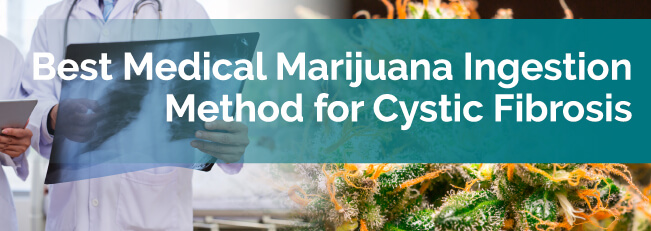
Cystic fibrosis takes a toll on your entire body. It makes your digestive fluids, sweat and mucus much thicker, causing difficulties with the respiratory and digestion systems. While there isn’t a cure for cystic fibrosis, you can manage your symptoms with proper treatment.
Since cystic fibrosis causes so many symptoms, there are tons of different drugs used for it. Some examples include inhalers, anti-inflammatory meds and mucus thinners. Every cystic fibrosis patient’s treatment is unique because it affects everyone differently.
Some patients prefer holistic cures over standard medicine for personal or medical reasons. Although the symptoms of cystic fibrosis can make it difficult to absorb certain forms of medicine, medical marijuana can reduce the severity of the disease. But, not every method of taking medical marijuana will work well for you.
We’re going to break down each marijuana consumption method and tell you how effective each one is for patients suffering from cystic fibrosis.
The most common way to consume marijuana is smoking it. Smoking produces a more immediate effect for patients who need quicker relief.
However, as you might imagine, smoking marijuana isn’t ideal for patients dealing with cystic fibrosis. Like smoking tobacco, smoking weed releases tar that’s unhealthy for everyone’s lungs, regardless of illness. Smoking exacerbates the respiratory symptoms of cystic fibrosis.
Vaping has similar benefits to smoking with less side effects. It can produce some tar if the bud or concentrate in the vape pen gets burnt, but higher quality vape pens that are properly used create less tar. When used correctly, vaping will let you feel relief more quickly with fewer detriments.
Since medical marijuana is an anti-inflammatory, vaping it can reduce the inflammation in your lungs, which helps them function and lessens swelling.
Marijuana edibles kick in later than inhalation does, but the beneficial effects last longer. They’re also ideal for folks who don’t like the idea of inhaling marijuana.
Edibles could help with cystic fibrosis symptoms if dosed carefully. Cystic fibrosis makes it harder to absorb the nutrients from food, so sufferers must eat more. While edibles come in many high-calorie forms, you need to work closely with your doctor and budtender to figure out a dosage that your stomach can absorb without being too potent.
Cystic fibrosis can cause numerous pain symptoms. Due to its effects on the respiratory system, it can cause pain in the chest and appendix. The digestive problems caused by cystic fibrosis sometimes result in kidney stones and gallstones that also hurt.
Cannabis-infused lotions can be used to relieve pain in a targeted area. They’re most effective for any soreness in your muscles or other areas close to your skin.
Cannabis patches are a topical treatment that goes deeper than lotions and creams do. While lotions and creams only take effect on a skin-deep level, the medicine in patches can enter your bloodstream and affect your entire body. When you use a patch, you don’t have to worry about the mucus in your stomach or lungs getting in the way of absorbing your medicine.
Tinctures are one of the oldest marijuana medicines around. Before marijuana was federally outlawed, doctors prescribed cannabis tinctures to their patients. A tincture is a mixture of cannabis and alcohol or glycerin that you consume sublingually.
Since tinctures are absorbed in your mouth, you can use them to take advantage of all the benefits of MMJ. Like patches, the medicine in tinctures get absorbed directly into your bloodstream.
Patches and tinctures are probably the best way to use medical marijuana when you have cystic fibrosis. Edibles, topicals and vaping could also work for you, but we recommend working closely with your doctor and budtender when you try them. We don’t recommend smoking marijuana when you have cystic fibrosis due to the toxins it generates.
For more information about how cannabis can be used to treat Cystic Fibrosis, check out our resources: